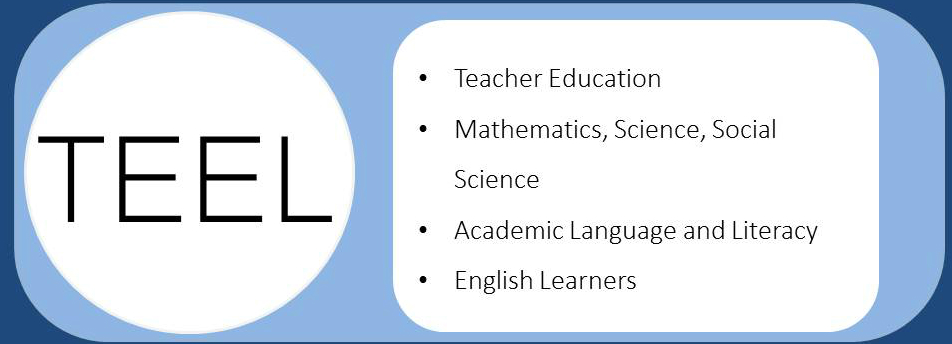To demonstrate how we anticipate SSTELLA trained teachers would teach, even during the first years of teaching, we present a hypothetical science lesson vignette followed by commentary on how the lesson exemplifies specific elements of SSTELLA instructional practices – elements further explicated via an observation rubric (see Table 1, Research Methods section).
Ms. C is teaching a thermochemistry lesson for 10th/11th grade students including some ELL and former-ELL students. The lesson builds on physical properties of matter to create a heating/cooling curve model for water that students will later use for energy calculations.
Ms. C begins by using a document camera (doc-u-cam) to display the phrase, “Uses of steam in the home” and a photo of steam coming up from a teapot. She asks for student suggestions, and they offer “cooking vegetables” and “ironing.” One student says, “My mom once used steam to clean a stain on the carpet.” Ms. C records these suggestions, then shows students a container of ice cubes: “Let’s say I need some steam to clean my carpet, but all I have is this ice. How could I turn this into steam?” Students offer: “heat it” and “put it in a pot of boiling water.” Ms. C probes further: “How long would it take?” and “what factors might I need to consider?” She makes sure that Juan, an emerging bilingual, participates: “Juan, what could you add on?” and encourages students to build on each other using a sentence frame ([Name of peer], I agree/disagree that [restate peer’s comment]; therefore,…). Olivia states: “Juan, I agree that steam is ‘hot.’ Therefore, it should have more energy.” The shared perspectives lead students to generate, collectively, a hypothesized visual model (Fig 2a) of the phase changes of water when energy is applied.
Ms. C refines the problem: “We really want to know the relationship between energy and temperature in these phase changes. Is the relationship linear?” She writes the question with the doc-u-cam and invites another ELL student to write the question in Spanish – ¿Cuál es la relación entre la energía y la temperatura, es la relación lineal? Students record both versions in their science notebook. The lesson continues with students working with water, ice, a heating device, and thermometer in heterogeneous groups (by EL proficiency and class grade) to test the model. Some students observe their ice at a temperature lower than 0˚C. While walking around the class, Ms. C encourages students in one group to think about what this means for the visual model they have created. The students recognize the need to relocate the position of the first beaker in the diagram. Additional observations lead students to notice that their thermometer stays at zero degrees while the ice melts.
At the end of the activity, Ms. C displays a sentence frame: “I claim that the diagram should really look like…. because…..” reminding students that scientists explain science by making claims that they support with evidence. She refers students to the class-generated science word wall and the “student-friendly” definitions of claims and evidence previously recorded in their science notebooks. Moving around the classroom, she asks students to share what they have written and provides feedback on their writing. Finally, in a mini-poster session, Ms. C uses a cooperative structure, e.g. Numbered Heads Together, to ensure equitable participation as student groups share their explanations to the whole class, which leads to a discussion about how to amend the initial heating/cooling curve diagram. Ms. C draws the revised model to match the model the students have developed (Fig 2b) and then returns to the question of the energy and temperature relationship during phase changes inviting students to share experiences outside the classroom where they can apply their model.
Figure 4. A “STELLA infused” science lesson vignette
Teachers, such as Ms. C, help students make sense of natural phenomenon through explicit communication and reflection of a “big idea,” driven by an ill-defined question: “How could I turn this [ice] into steam?” The collaborative generation of a partial model (first heating/cooling diagram), followed by testing and refining the model, presses student engagement in scientific practices using complex English language functions. Rather than evaluate student responses to her questions (Cazden, 1988), Ms. C facilitates productive student talk by eliciting student conceptions and hypotheses throughout the lesson (e.g., how to turn ice into steam) and activates collaborative talk among her ELL students, increasing student access to science discourse and concepts. Individually and through small groups, Ms C presses students to explain and discuss/critique their models as well as produce an authentic scientific text. She scaffolds students’ discourse through meta-discursive awareness (sentence frames, science notebook) and targeted feedback (Hanauer, 2008; Lemke, 2000). Students’ English language and literacy are not only developed through the authentic literacy task of writing a scientific argument, but also through the development and use of science vocabulary “claim” and “evidence” recorded in their science notebook. Ms. C contextualizes the science activity by making connections to students’ observations of steam in their homes, which she used to extend the lesson by drawing on a specific experience (using steam to clean the carpet). Finally, she closes the lesson by once again inviting students to share ways in which they could apply what they have learned, leveraging experiences for learning complex science content (Moll, et al, 1992; Rosebery & Warren, 2008). In a follow up lesson, Ms. C might scaffold and contextualize another literacy (reading) activity, using reciprocal reading (Palinscar & Brown, 1984) to read about how scientists are finding “greener” ways to harness steam energy:
